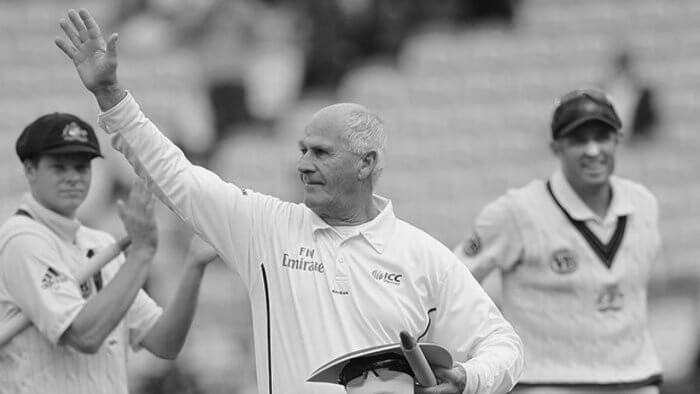
RUDI KOERTZEN: “THE SLOW-DEATH” VANISHES AT 73
Rudi Koertzen..!! Not just a name but one of the finest of the game. There comes a time when all the people associated with the sport must leave the stage. Some choose their moment of departure while others are forced out. Whatever the manner of exit, it is always a deeply poignant moment for a person who has been living the particular sport for ages. Rudi chose his moment in 2010 at Headingley.
But he didn’t choose this moment after 12 long years of his retirement. Rudi passed away in a car accident at the age of 73.
BID ADIEU
We as cricket fans were sad when we first discovered that we would not see him again when we saw Kangaroos giving him a guard of honor at the Headingley in 2010. Rudi was bidding adieu.
The Umpires are indeed an important but unnoticed aspect of the game like a wicket-keeper. He too is noticed only when he errs. He too, like the wicket-keeper is expected to be in the game at all times. But he is on the field when both sides bat, unlike the wicket-keeper. He may not perform on the field the heroics of a batsman or a bowler but he can be a reason for a million smiles and tears by raising his finger. His fallibility at Lord’s can be registered in mind (Simon Taufel giving Sachin out on 91), nobody registers in his/her mind the cricketer who in the excitement of the moment runs his partner out (Atherton ran out by his partner Mike Gatting on 99). All day long, the umpire must keep his mind intensely on the game.
STUBBORN RUDI
Rudi was one such volunteer of the game who stood there deciding some key moments in the player’s life. When he first stood as an Umpire, Kepler Wessels said to him, “You're not going to have an easy road to walk. It's going to be tough and the guys are going to put so much pressure on you and you're not going to survive.” To which he replied, "Kepler, you don't know me - the more pressure you put on me, the thicker my skin gets, and the thicker my skin gets the more difficult it will be to get anything out of me."
In September 1999, he was praised for his refusal to take a bribe for Coca-Cola Cup final match between West Indies and India in Singapore, and four months later he once again witnessed the match-fixing scenes when he stood in the infamous Centurion Test between South Africa and England.
THE SLOW DEATH
Rudi Koertzen rose to the stature of being called a slow death for his agonizingly torturing enigma of raising a finger so slowly that it seemed a reversible process. It was not a deliberately done act though but it created a moment of excitement in the minds of players. An act which every spectator who watched him doing so thoroughly enjoyed. “Where did it come from?” asked someone and he says, “When I started to umpire, I used to stand with my hands in front of me. I remember my wife was watching a TV game one day where I was officiating and she said to me, "Take your hands away from your front and put them behind your back." I started doing that, but then I started to fiddle around with my hands - it's in my pocket, then it's on my side - so I decided to grip my left wrist with my right hand and hold it there so I couldn't move it around. Because I would hang on to it, it just came naturally that I would count one, two, three, think where the ball was going, and then have a slow release and start lifting it. It just stayed with me - I don't think it was something deliberate.”
The slow-rising finger, making batsmen’s 6 seconds worse as hell can never be forgotten. Daryl Cullinan was batting at Wanderers “How’s That?”, asked the bowler, and Rudi kept staring at Daryl for 4 seconds, and then came a slow finger like a sword giving him a slow death. Cullinan said, "Why do you make me suffer and wait for that slow-death decision?” That’s how Rudi got his name “The Slow Death”.
CONTROVERSIES
Well, no one can say Rudi did it purposely but then all his major wrong decisions came against Sri Lanka. In 2001 two obvious wrong decisions made against Sri Lanka brought him criticism from the Lankan fans. And then came the 2007 World cup where his two warnings to Dilhara Fernando for stepping in the middle of the crease on his follow-through brought him the wrath of Lankan Fans again. In the finals, his misinterpretation of the rules regarding bad light brought him a suspension from officiating the inaugural ICC T20 World cup.
When Sri Lanka played their 2nd Test at Hobart chasing a target of over 500, Sangakara lead from one end and was given out caught at slip after a ball brushed off his shoulders while pulling. Sangakkara missed his double ton by 8 runs and Sri Lanka lost the match by 96 runs.
He retired from international umpiring in 2010 in the match between Pakistan and Australia at the Headingley.
STATS
Rudi officiated in 128 Tests, out of which he took the field 108 times, and was a TV umpire for 20 Tests. He was seen 209 times on the field as an Umpire in ODI cricket while only 14 T20 games came to his fate.


 Durgesh Bhende
Durgesh Bhende
Write a Comment